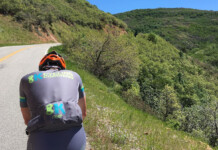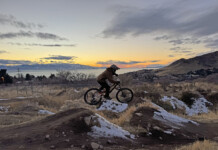By Bryson Perry
In June, Mark Deterline gave us some great instruction on how to corner on a road bike in an article entitled Buy the Stamp. This month we are coming into some of the best off-road riding of the year, so we will now address cornering on an MTB.
This past weekend’s Park City Point 2 Point was a course where cornering skill was a must. Especially on the TG, John’s 99 and John’s trails, you had to be on your game or lost major time. The keys to riding these trails fast consist of at least some fundamental skills, as well as the confidence to implement them.
As was discussed in the last article, the contact patch of a road bike tire is about the size of a postage stamp. On a mountain bike that patch is enlarged to roughly the size of your favorite credit card. Add to those static physics the fact that the contact patch of an mtb tire will drift and slide, you can’t rely totally on continuous grip. So you have to gain the skill to keep your bike under control despite the more dynamic nature of MTB tread.
Generally speaking, to corner confidently on an MTB, keep in mind these five fundamentals:
1- Make sure your bike is set up properly before you start.
2- Focus on where you want to go.
3- Stay loose and relaxed; don’t think about it too much, just go for it.
4- Do any braking BEFORE you enter a turn.
5- Once you are in the turn, rip it!
1- Before you start
Before hitting the trails you need to make sure your bike is ready to go. If your tire pressure is too high or too low it will greatly affect your traction in corners.
Also your tire selection will make a big difference. I suggest talking to staff at your local bike shop, explaining where you plan to ride. A good shop will ask questions about your skill level then suggest a tire well suited to your personal needs.
For riding in the Wasatch Mountains and on Draper trails, I like the Specialized Renegade, but a knobbier tire might be better for you. I run about 25 psi (pounds per square inch) in the front tire and 27 psi in the rear, both mounted to ENVE twenty6 XC wheels. Your wheels may be different, but as a general rule if you are running tubeless you’ll want to be around 25-30 psi.
If you are not running tubeless tires, come join us in the 21st century – innertubes are really only for emergencies now. For less than $100 you can make any bike tubeless and run lower tire pressures that will give you more traction on the trails. Your suspension will also be more effective.
You will want your local shop to likewise set up your suspension based on your riding style, level and bodyweight; every shock, bike and rider is different. Once you’ve determined your ideal tire pressures based on those variables, make sure to check them before each ride.
2- Focus on where you want to go
As you come up to a turn on your MTB, the first thing you need to do is determine where you want to end up after it. Quickly scan the trail, pick your line and commit to it. Sometimes you will not be able to see the entire trail so you will have to take an educated guess as to what will be coming based on the terrain you have covered so far. The key, regardless, is to quickly look where you want to go – and go there.
It is so easy to look at that big rock or root on the trail and think “Oh [enter expletive of your choice], I’m gonna hit that.” If this is you, my guess is that you are usually right. That is no way to ride with confidence. You must pick your line, focus on it then zone out the rest of the mess that could distract you and cause a mishap. Focus on riding your line as cleanly and smoothly as you can; avoid the temptation to think about not crashing, or even worse, about crashing.
3- Stay loose
The next step when you come up to the corner is to stay loose. Tight, stiff arms and legs don’t absorb terrain – or little errors you may make along the way. Go into the turn with your feet at the 3 and 9 o’clock positions, ready to absorb upcoming obstacles. Grip the bar firmly so your hands don’t slip off, but let your arms, back, shoulders and legs relax. If you pick your line then stay loose, you won’t be as likely to get bucked if you do happen to hit something big and/or unexpected.
4- Brake before the turn
Cornering smoothly means you must carry the right speed into a turn. This will take practice. As you approach a turn, but before you enter it, you should brake with both the front and rear brakes to attain an appropriate speed.
Braking while cornering will straighten your bike’s path of travel, changing your targeted line through the turn. It can also cause one of your tires to skid. Since front tire traction is your highest priority, avoid use of your front brake while cornering; you should only do so when absolutely necessary, and even then with great caution.
If you still have too much speed once you enter a turn, you will likely need to switch to rear brake only so that you can help work the bike through it. Skidding is not ideal but sometimes necessary to get the bike around if you carried too much speed into the turn. You will actually corner faster if you can brake beforehand then carry that speed through the turn.
5- Grip it and rip it
You have made it 75% of the way through the turn. Once you make it to this point it is time to look well ahead, potentially into the next one. Many people are still focused on the final 25%, but by this point the turn has essentially been navigated and it is time to get going again. Let the bike roll out of the corner, or pedal out of the corner if possible, to get back up to speed.
Momentum is what keeps the bike going straight. When you are riding at speed is it much easier to hold your line and go where you want to. If you go too slow, you will have to use more energy and focus just to keep your balance, instead of what you want to do – ride the trail cleanly and efficiently.
My motto is Grip it and rip it. But to go along with Mark’s purchasing commitment motto, Buy the stamp, I guess I can go with Just charge it!








